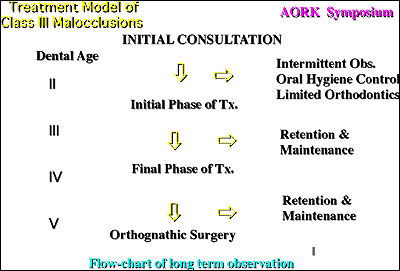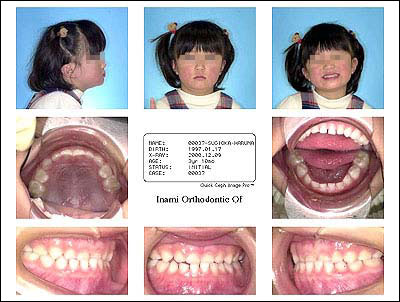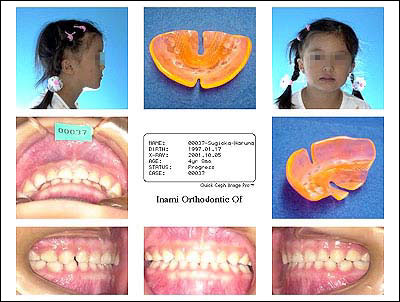|
Oct. 9 (Tue.), 2001
|
 |
|
|
5. Models of Class III treatment
|
The following model of Class III treatment was presented at the Sendai Class III Symposium.
|

|
The patient is to be classified by severity of skeletal discrepancy into either serious or mild/moderate category at the time of the initial examination. However, it is not clearly shown which reference plane, SN or FH, or what cut-off ANB or facial angle value (SD value) to be used. A mathematical equation for classification was proposed in the past but is rather complex for clinicians like myself. Nevertheless, the model clearly depicts the process of Class III treatment.
The following model is the one I presented during the AORK Symposium. Thinking that it would be difficult to draw a line between 'severe' and 'mild to moderate' only based on the initial data, I judged that the severity of Class III problem should be determined after the observation of patient response to treatment for a given period of time.
|

|
A crossbite of primary teeth may cause the mandible to functionally shift forward or assume a habitual forward position. To eliminate these modifying factors, it is necessary to correct the crossbite with a functional orthodontic appliance even if it is a skeletal problem. The clinician should not immediately resort to the use of a chin cup to correct the forward mandibular position or a facial mask to pull the maxilla forward. The use of a maxillary appliance covering the palate should also be avoided since it interferes with tongue movement to the detriment of maxillary growth and development. Thus, a rapid maxillary expander, a quad-helix expander or the Porter expander should not be the first choice for the primary dentition.
The functional appliances that I use in my clinical practice are the FR-3 of Frankel and the Moo Appliance (developed by Dr. Munemitsu Yanagisawa of Chofu Orthodontic Clinic), which is superior to the Frankel appliance. A clinical cased treated with the Moo Appliance is shown below.
|

|

|
|
|